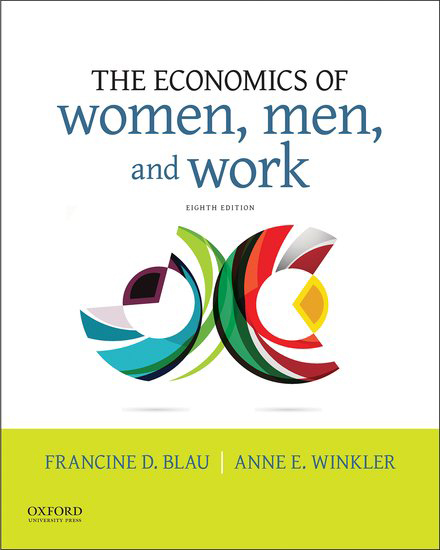
Anne Winkler, chair of the Department of Economics, co-authored the book “The Economics of Women, Men and Work,” published last summer in its eighth edition by Oxford University Press. (Photo by August Jennewein)
Anne Winkler has done extensive research throughout her career on the role gender plays in the labor market.
Last summer, the chair of the Department of Economics at the University of Missouri–St. Louis joined her co-author, Francine D. Blau, in publishing the eighth edition of their textbook “The Economics of Women, Men and Work” from Oxford University Press.
Winkler and Blau have also penned a chapter in another upcoming Oxford book on “Women, Work and Family,” and Winkler is slated to deliver a keynote address on that topic April 12 at the American Academy of Economic and Financial Experts’ annual conference in Las Vegas.
In this Women’s History Month edition of the “Ask an Expert” series, UMSL Daily spoke to Winkler about the gains women have made in the labor force and what barriers remain that keep them from standing on level ground with their male counterparts.
I have noted that the Equal Pay Act was signed into law by John F. Kennedy in 1963, and the issue of pay equity has been an issue that people have been conscious about trying to change at least since then. How much progress has been made?
Well, if we went back, maybe not all the way back to the 1960s, but to, say, the 1970s, women were wearing these buttons – in fact, my mother has one of these buttons – that said 59 cents. It was a big visual all throughout the 1970s. If you look at the ratio of women’s to men’s earnings, you’ll see that at that time women earned 59 percent of what men earned.
Where are we today? I think that’s sort of the general nature of your question. The answer is that the ratio today is closer to 80 or 82 cents, depending on the different data sources people use. So that’s quite an improvement.
Another way to look at this is that the pay gap used to be 41 cents, and now the pay gap is 20 cents. Obviously, there’s a big part of the gap that hasn’t closed, and that raises a number of issues – “Why hasn’t it closed?” but also, “Why has the pay gap declined as much as it has?”
What are the primary causes of the declining pay gap?
Economists typically look at three major factors. The first factor has to do with what economists call human capital. That’s the set of skills and knowledge that you bring to the job. What’s happened over that period is that women’s qualifications have increased tremendously compared to men’s. As an example, women’s educational attainment has dramatically increased and, in fact, you can see this here at UMSL, where if you take a look at enrollment, I think right now we’re at around 60 percent female, 40 percent male. Another important piece is that the amount of labor market experience that women have – that is the amount of years in the labor market – is getting closer and closer to the amount of years in the labor market for men.
The second factor is a decline in what is termed labor market discrimination – differences in pay after you’ve accounted for differences in measured human capital. But there are oftentimes attributes that we can’t statistically control for given the data at hand, for example, college major or non-cognitive skills, such as interpersonal skills.
The latter tends to be an attribute that favors women and has helped women narrow the pay gap. Also, women are choosing, to some extent, more nontraditional majors, so that’s another piece of the explanation.
The third big factor that we look at is what economists call wage structure, or the differential rewards that individuals get for different skills and in different occupations. Basically, what’s been happening is that the rewards to being employed in male-dominated occupations have been going up. To the extent that women do not tend to be in these occupations, by definition, this factor works against them.
So, the first two factors have worked in women’s favor while this third factor has worked against. On net, the first two factors dominate, which explains the progress which has been made.
It’s also true that the rate at which the gap is closing has slowed over the past two decades. What more can be done to hasten it?
One big area is gender roles in the household. There’s just no question, and there’s good evidence, that women continue to bear a much greater responsibility for household tasks. For example, just in terms of time use data, the amount of time women spend on housework compared to men is about one and a half times as much. This number hasn’t really changed that much in recent years.
In terms of household responsibilities, I am referring to cleaning and shopping and those kinds of things. But to give you a sense of improvement, if you went back to the 1960s, that number was seven times as much.
Interestingly, it’s not that men are doing so much more, it’s that women are doing so much less. We can outsource. People have dirtier houses. There are also increasing numbers of market substitutes that reduce housework time.
Men’s time spent in childcare activities has picked up, especially married men. So, that’s a very positive development.
Another factor economists point to are family policies. In the United States, we simply don’t have the same kind of generous leave policies that we have elsewhere. We’re the only economically advanced country that lacks paid family leave.
Another part of that story is that we continue to lack an adequate amount of high-quality, affordable childcare.
I recently was reading about a study by Princeton economist Henrik Kleven that talked about the wage gap as really being a child penalty. Thoughts?
Yes, that is certainly a definite factor. Economists find that even when you compare mothers and non-mothers who have the same amount of labor market experience and other same measured characteristics, mothers earn less than non-mothers. We have really tried to understand where that difference is coming from. Mothers have a lot of household responsibilities still, so part of the explanation is that they may be choosing jobs with more flexibility, but jobs with more flexibility also tend to come with lower pay.
There’s also evidence that there’s what we might call raw discrimination. There have been field and lab experiments done that find that when otherwise identical resumes are compared, mothers are evaluated as less committed, for instance. When they do the same for fathers, fathers don’t bear the same penalty. Fathers are viewed as being more committed than non-fathers.
To the question of how long it takes to actually close the wage gap all the way, if you have that sort of discrimination that’s really hard to measure, are there ways to address it?
I think there’s feedback. As women become more attached to the labor force, I think it feeds back into the home in terms of gender roles between women and men. And as gender roles change between women and men in the household, that makes things more equal in the workplace because then women and men have more similar burdens. But we do see that traditional gender roles in the household are taking time to erode. It’s not a speedy process.
What does the wage gap look like for minority women compared to women overall?
People talk about a double disadvantage because in the labor market a minority woman may face both race discrimination and gender discrimination. You can see evidence of this when you look at gender pay ratios and gaps.
I know you’ve done research on earning dynamics among couples. Overall, what have you observed?
If we look at raw census data and we look at dual-earner couples, we see that the fraction of those couples in which the wife out earns the husband has been going up, so right now that number is very close to 30 percent. One thing that economists are interested in is what does that mean? You might think that as women out earn their husbands at least to some degree that might have some effect on their bargaining power in the family – for instance, the extent to which they could bargain away the amount of housework that they would have to do.
In my research from the mid-2000s with a former colleague, Tim McBride, and a UMSL MPPA grad, Courtney Andrews, we looked at couples in which the wife out earned her husband and found that this pattern was fairly permanent – persisted over a three-year period – in about 60 percent of couples. In 40 percent, it was more transitory. For the latter group, there would likely be less of a shift in bargaining power.
How does educational attainment play into this? What’s the difference for women who don’t have college degrees versus women who would have, say, a master’s degree or a PhD?
I think we always want to be cognizant of the fact that not all people are college-educated or have high earnings, so we want to look at patterns at different places in the earnings distribution. For instance, the factors behind a wife out earning her husband in a very low-earning couple may be very different from those associated with a wife out earning her husband in a high-earning couple.
An important related topic that’s covered in my recent Oxford chapter is there’s long been an educational divide in family and labor market outcomes, and the divide is growing. From a policy standpoint, this development has important implications in terms of income inequality.
How does the United States compare to other Western or developed countries in terms of the wage gap?

“The Economics of Women, Men and Work” was published last summer in its eighth edition by Oxford University Press.
In our textbook, we compare the United States to 14 other economically advanced countries – Japan and various Western European countries. The United States falls in about the middle. Japan is at the bottom of the group in terms of the gender wage ratio. The Nordic countries are closer to the top. A lot of where the U.S. lands relative to the Nordic countries has to do with the wage structure that we talked about before. In those countries, the wage structure is much more compressed than here in the United States, partly because they have much greater rates of unionization. Unionization rates bring the bottom up, and to the extent that women earn less than men, that factor lifts up the wages of women.
How different is the rate of labor force participation among men and women, and how has that changed?
Those rates have changed a lot over time. If we went back to 1960, women’s labor force participation was 38 percent, and men’s labor force participation rate was 83 percent. So at that time, that was a 45-point gap. Now, what’s amazing is that the gap is down to 12 points. In 2015, the women’s number was 57, and the men’s number was 69.
Beyond pay – and we just touched on one with the labor force participation rate – what are some signs that women’s status in the workforce has changed for the better?
I think there are lots of signs. We see women entering a lot of historically male-dominated fields. There’s no question we see that. We see women entering majors that they didn’t use to occupy as much. We see a greater fraction of women moving into higher-profile positions. I think the issue is the speed at which this is occurring and what obstacles are really standing in the way of women making continued progress.
Policy can play a role to some extent. While I don’t think it can play that much of a role in changing gender roles in the household, there are potential policy levers in terms of family policy, childcare policy and workplace policy. I would just add that when it comes to family policy, if we want to see real progress, it is critical that men make use of the policy too.














